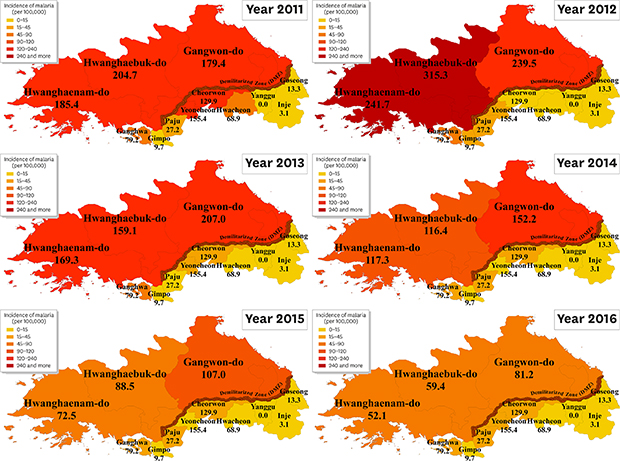1. Shin DH, Seo M, Hong JH, Lee E. Paleopathological considerations on malaria infection in Korea before the 20th century. BioMed Res Int. 2018; 2018:8516785.

2. Hasegawa Y. Malaria in Korea. J Chosun Med Soc. 1913; 4(4):53–69.
3. Himeno K. Malaria occurring at Kangnung area, Kangwon-do. Mansen no Ikai. 1926; 62(62):59–66.
4. Yeo I. A history of malaria in modern Korea 1876–1945. Korean J Med Hist. 2011; 20(1):53–82.
5. Ree HI. Unstable vivax malaria in Korea. Korean J Parasitol. 2000; 38(3):119–138.

6. National Malaria Eradication Service, Ministry of Health and Social Affairs. Malaria Pre-eradication Programme in Korea, 1961–1965 Progress Report. Seoul: Ministry of Health and Social Affairs;1966. p. 44–75.
7. Paik YH, Tsai FC. A note on the epidemiology of Korean vivax malaria. New Med J. 1963; 6(2):37–43.
8. World Health Organization. Synopsis of the world malaria situation, 1979. Wkly Epidemiol Rec. 1981; 56(19):145–149.
9. Paik YH, Ree HI, Shim JC. Malaria in Korea. Jpn J Exp Med. 1988; 58(2):55–66.
10. Cho SY, Kong Y, Park SM, Lee JS, Lim YA, Chae SL, et al. Two vivax malaria cases detected in Korea. Korean J Parasitol. 1994; 32(4):281–284.

11. The Korea Centers for Disease Control and Prevention. Infectious Diseases Surveillance Yearbook 2017. Cheongju: The Korea Centers for Disease Control and Prevention;2018.
12. Chol PT, Suwannapong N, Howteerakul N. Evaluation of a malaria control project in DPR Korea, 2001–2003. Southeast Asian J Trop Med Public Health. 2005; 36(3):565–571.
13. Pant SD, Chol KY, Tegegn Y, Mandal PP, Chol RK. Mass primaquine preventive treatment for control of Plasmodium vivax malaria in the Democratic People's Republic of Korea: a country success story. WHO South-East Asia J Public Health. 2014; 3(1):75–80.
14. Mercado CE, Ekapirat N, Dondorp AM, Maude RJ. An assessment of national surveillance systems for malaria elimination in the Asia Pacific. Malar J. 2017; 16(1):127.

15. National Malaria Programme, Ministry of Public Health. National Malaria Elimination Strategy 2018–2022: Democratic People's Republic of Korea. Pyongyang: World Health Organization, Country Office for DPR Korea;2017.
16. Ree HI. Can malaria be endemic in South Korea? Korean J Infect Dis. 1998; 30(4):397–400.
17. Lee JS, Lee WJ, Cho SH, Ree HI. Outbreak of vivax malaria in areas adjacent to the demilitarized zone, South Korea, 1998. Am J Trop Med Hyg. 2002; 66(1):13–17.

19. Division of Infectious Disease Control, The Korea Centers for Disease Control and Prevention. Report on the participation of the technical consultative meeting on malaria in South and North Korea and related countries, 2009 [Internet]. Accessed March 15, 2019.
https://btis.mpm.go.kr/cmm/main/mainPage.do, Report number=51352.
22. Central Bureau of Statistics. DPR Korea 2008 Population Census National Report. Pyongyang: Central Bureau of Statistics;2009.
24. Burki T. North Korea and the global fund. Lancet Infect Dis. 2018; 18(5):501.

25. Bhatia R, Thorne-Lyman AL. Food shortages and nutrition in North Korea. Lancet. 2002; 360:Suppl. s27–8.

26. Grundy J, Moodie R. An approach to health system strengthening in the Democratic Peoples Republic of Korea (North Korea). Int J Health Plann Manage. 2009; 24(2):113–129.
27. Gyeonggi Research Institute. Gyeonggi Policy Research 2016-52. Inter-Korean Cooperation and Gyeonggi-Do. Suwon: Gyeonggi Research Institute;2016. p. 1–170.
29. Schwekendiek D. Regional variations in living conditions during the North Korean food crisis of the 1990s. Asia Pac J Public Health. 2010; 22(4):460–476.

30. McCurry J. Aid workers warn of North Korea's forgotten health crisis. Lancet. 2005; 365(9476):1997–1998.

31. Grundy J, Biggs BA, Hipgrave DB. Public health and international partnerships in the Democratic People's Republic of Korea. PLoS Med. 2015; 12(12):e1001929.

32. Owen-Davies J. North Korea's public health tragedy. Lancet. 2001; 357(9256):628–630.

33. Centers for Disease Control and Prevention (CDC). Status of public health--Democratic People's Republic of Korea, April 1997. MMWR Morb Mortal Wkly Rep. 1997; 46(24):561–565.
34. Ahmad K. Explosion in North Korea destroys health facilities. Lancet. 2004; 363(9419):1447.

35. Cho SH, Lee HW, Shin EH, Lee HI, Lee WG, Kim CH, et al. A mark-release-recapture experiment with Anopheles sinensis in the northern part of Gyeonggi-do, Korea. Korean J Parasitol. 2002; 40(3):139–148.






 PDF
PDF Citation
Citation Print
Print







 XML Download
XML Download